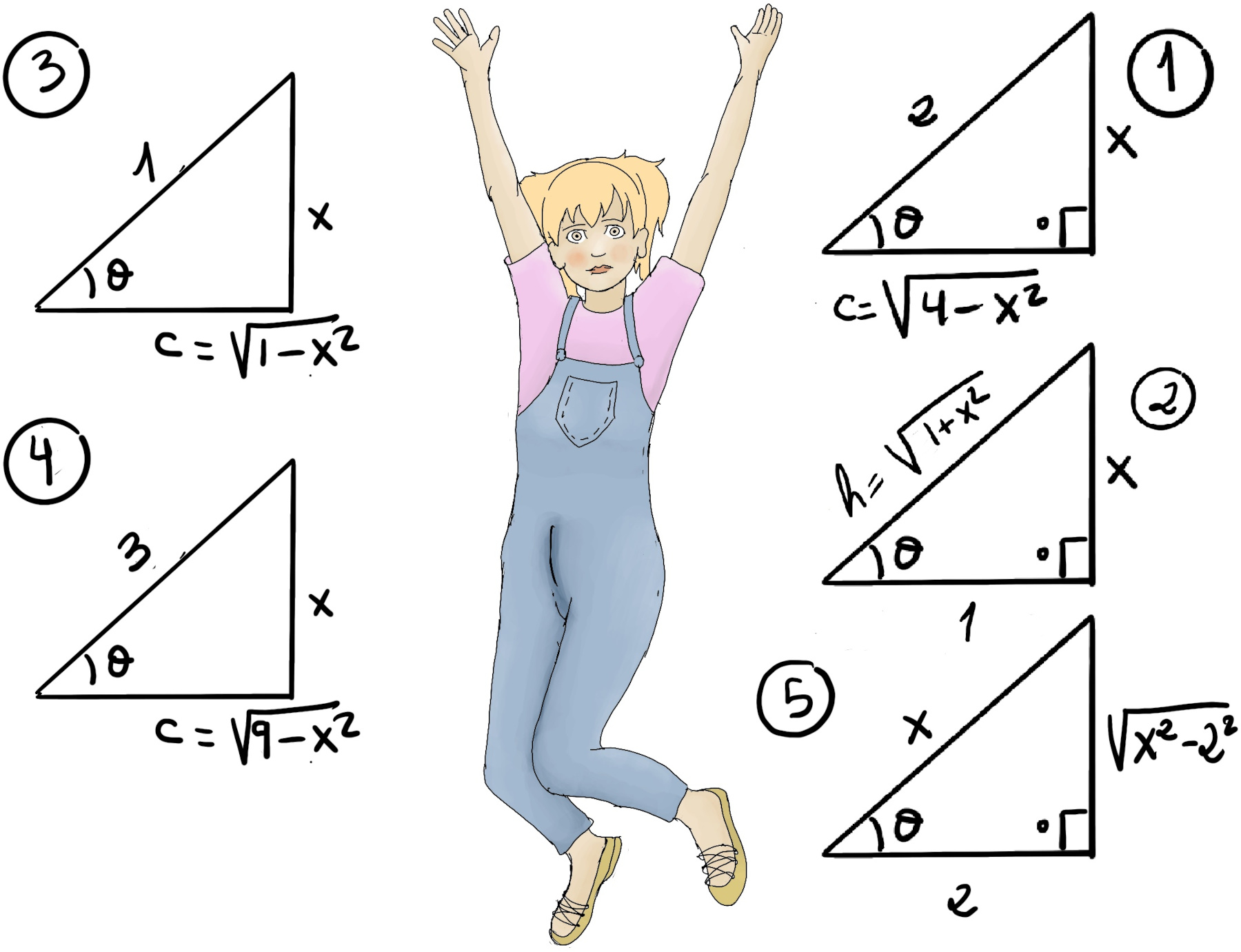
|
 |
 |

|
 |
 |
Beneath this mask there is more than flesh. Beneath this mask there is an idea, Mr. Creedy, and ideas are bulletproof, V for Vendetta.
In calculus, an antiderivative or indefinite integral, G, of a function g, is the function that can be differentiated to obtain the original function, that is, G’ = f.
G(x) = $\int f(x)dx$
Trigonometry is a branch of mathematics that deals with the relationships between the sides and angles of triangles.

Here are some of the main important trigonometric definitions and formulas:
Functions of Right Triangles. $\sin(\theta) = \frac{\text{opposite}}{\text{hypotenuse}}, \cos(\theta) = \frac{\text{adjacent}}{\text{hypotenuse}}, \tan(\theta) = \frac{\sin(\theta)}{\cos(\theta)}, \cot(\theta) = \frac{1}{\tan(\theta)}, \sec(\theta) = \frac{1}{\cos(\theta)}, \csc(\theta) = \frac{1}{\sin(\theta)}$
Pythagorean Identities: $\sin^2(θ) + \cos^2(θ) = 1, 1 + \tan^2(θ) = \sec^2(θ), 1 + \cot^2(θ) = \csc^2(x)$
Complementary angles: $\sin\left(\frac{\pi}{2} - x\right) = \cos(x), \cos\left(\frac{\pi}{2} - x\right) = \sin(x), \tan\left(\frac{\pi}{2} - x\right) = \cot(x), \cot\left(\frac{\pi}{2} - x\right) = \tan(x), \sec\left(\frac{\pi}{2} - x\right) = \csc(x), \csc\left(\frac{\pi}{2} - x\right) = \sec(x).$
Addition and Subtraction Formulas: $\sin(x \pm y) = \sin(x)\cos(y) \pm \cos(x)\sin(y), \cos(x \pm y) = \cos(x)\cos(y) \mp \sin(x)\sin(y), \tan(x \pm y) = \frac{\tan(x) \pm \tan(y)}{1 \mp \tan(x)\tan(y)}.$
Double Angle Formulas: $\sin(2θ) = 2\sin(θ)\cos(θ), \cos(2θ) = \cos^2(θ) - \sin^2(θ) = 2\cos^2(θ) - 1 = 1 - 2\sin^2(θ), tan(2θ) = \frac{2\tan(θ)}{1 - \tan^2(θ)}.$
cos(2θ) = cos2(θ) -sin2(θ) =[sin2(θ) + cos2(θ) = 1] cos2(θ) -(1 - cos2(θ)) = 2cos2(θ) -1 ⇒ cos2(θ) = (1 + cos(2θ))⁄2. Similarly, sin2(θ) = (1 - cos(2θ))⁄2.
Half-Angle Formulas: $\sin^2\left(\frac{θ}{2}\right) = \frac{1 - \cos(θ)}{2} ↭ \sin(\frac{θ}{2}) = ±\sqrt{\frac{1 - \cos(θ)}{2}}, \cos^2\left(\frac{θ}{2}\right) = \frac{1 + \cos(θ)}{2} ↭ \cos(\frac{θ}{2}) = ±\sqrt{\frac{1 + \cos(θ)}{2}}, \tan\left(\frac{θ}{2}\right) = \frac{1 - \cos(θ)}{\sin(θ)} = \frac{\sin(θ)}{1 + \cos(θ)}.$
Derivatives of Trigonometric Formulas: sin’(x) = cos(x), cos’(x) = -sin(x), tan’(x) = sec2(x), sec’(x) = sec(x)tan(x), $\csc’(x) = -\csc(x) \cot(x), \cot’(x) = -\csc^2(x)$.
Integration formulas for trigonometry: $\int \sin(x)dx = -\cos(x) + C; \int \cos(x)dx = \sin(x) + C; \int \tan(x)dx = -\ln|\cos(x)| + C; \int \cot(x)dx = \ln|\sin(x)| + C; \int \sec(x)dx = \ln|\sec(x) + \tan(x)| + C; \int \csc(x)dx = -\ln|\csc(x) + \cot(x)| + C, \int sec(x)tan(x)dθ = sec(x) + C$
sec2(x) = $\frac{1}{cos^2(x)} = \frac{cos^2(x)+sin^2(x)}{cos^2(x)} = 1 + tan^2(x)$. Similarly, $\frac{d}{dx}tan(x) = \frac{d}{dx}\frac{sin(x)}{cos(x)} = \frac{cos^2(x)+sin^2(x)}{cos^2(x)} = \frac{1}{cos^2(x)}=sec^2(x)$. Besides, $\frac{d}{dx} sec(x) = \frac{d}{dx} \frac{1}{cos(x)} = \frac{sin(x)}{cos^2(x)} = sec(x)tan(x).$
Trigonometric substitution is a powerful technique used in calculus to simplify and solve integrals involving radical expressions.
It is another technique often used in calculus to simplify complex expressions to make integration more manageable.
$\int tan(x)dx = \int \frac{sin(x)}{cos(x)}dx$ [Trigonometry substitution, u = cos(x), du = -sin(x)dx] =$\int \frac{-du}{u} = -ln|u| + C = -ln|cos(x)| + C.$
$\int \sqrt{1-x^2}dx =$[Trigonometry substitution, x = sin(θ), dx = cos(θ)dθ] $\int \sqrt{1-sin^2(θ)}cos(θ)dθ = \int \sqrt{cos^2(θ)}cos(θ)dθ = \int cos^2(θ)dθ$ =[Double Angle Formulas, cos(2θ) = 2cos2(θ)-1 ⇒ $cos^2(θ) = \frac{1}{2}·(1+cos(2θ))$] $\frac{1}{2}\int (1+cos(2θ))dθ = \frac{1}{2}(θ+\frac{1}{2}sin(2θ))+C = \frac{1}{2}(θ+sin(θ)cos(θ))+C = \frac{1}{2}θ + \frac{1}{2}sin(θ)cos(θ)+C.$
Now, we need to backtrack our substitution (Figure 3), $x = sin(θ) ⇒ sin(θ)=\frac{x}{1} ⇒ θ = sin^{-1}(x), \int \sqrt{1-x^2}dx = \frac{1}{2}θ + \frac{1}{2}sin(θ)cos(θ)+C = \frac{1}{2}(sin^{-1}(x))+ \frac{1}{2}x\sqrt{1-x^2} + C.$

$\int sec(x)dx$ [This is no an easy one to come up with 😃!. u = sec(x)+tan(x), Recall previous section, derivatives of Trigonometric Formulas, (sec(x)+tan(x))’=(sec(x)tan(x)+sec2(x))=(sec(x) +tan(x))·sec(x), u’ = u·sec(x) ⇒ sec(x) = u’⁄u = d⁄duln|u|] $\int sec(x)dx$ = ln|u| = ln|sec(x) + tan(x)| + C. [🚀]
$\int \frac{\sqrt{x^2+1}}{x}dx =$[Trigonometry substitution, x = tan(θ), dx = sec2(θ)dθ] $\int \frac{\sqrt{tan^2(θ)+1}}{tan(θ)}sec^2(θ)dθ =$[Recall sec2(x) = 1 + tan2(x)] = $\int \frac{\sqrt{sec^2(θ)}}{tan(θ)}sec^2(θ)dθ = \int \frac{sec(θ)}{tan(θ)}sec^2(θ)dθ = \int csc(θ)(1+tan^2(θ))dθ = \int (csc(θ) + sec(θ)tan(θ))dθ = \int csc(θ)dθ + \int sec(θ)tan(θ)dθ$ =[Integration formulas for trigonometry, please notice that -ln|csc(θ)+cot(θ)| = ln|csc(θ)-cot(θ)|] $ ln|csc(θ)-cot(θ)| + sec(θ) + C.$
Now, we need to backtrack our substitution (Figure 2), $\frac{x}{1} = tan(θ).$ By the Pythagorean theorem, $1^2+x^2 = h^2 ⇒ h = \sqrt{1+x^2} ⇒ \int \frac{\sqrt{x^2+1}}{x}dx = ln|csc(θ)-cot(θ)| + sec(θ) + C = ln|\frac{\sqrt{1+x^2}}{x}-\frac{1}{x}|+\frac{\sqrt{1+x^2}}{1}+C = ln|\frac{\sqrt{1+x^2}-1}{x}|+\sqrt{1+x^2}+C.$

Let’s try to solve $\int sin^n(x)cos^m(x)dx$, e.g., $\int sin^n(x)cos(x)dx$ =[Substitution u = sin(x), du = cos(x)dx] $\int u^ndu = \frac{u^{n+1}}{n+1} + C = \frac{sin^{n+1}(x)}{n+1} + C.$
$\int sin^3(x)cos^2(x)dx$ =[sin2(θ) + cos2(θ) = 1] =$\int (1-cos^2(x))sin(x)cos^2(x)dx = \int (cos^2(x)-cos^4(x))sin(x)dx$ =[Substitution u = cos(x), du = -sin(x)dx] $\int (u^2-u^4)(-du) = -\frac{u^3}{3}+\frac{u^5}{5} + C= -\frac{cos^3(x)}{3}+\frac{cos^5(x)}{5} + C$.
$\int sin^3(x)dx$ =[sin2(θ) + cos2(θ) = 1] =$\int (1-cos^2(x))sin(x)dx$ =[Substitution u = cos(x), du = -sin(x)dx] $\int (1-u^2)(-du) = \int (-1+u^2)du = -u + \frac{u^3}{3} + C = -cos(x)+\frac{cos^3(x)}{x} + C$.
$\int cos^2(x)dx$ =[cos2(θ) = (1 + cos(2θ))⁄2] $\int \frac{1+cos(2x)}{2}dx = \int \frac{1}{2}dx + \int \frac{cos(2x)}{2}dx$ =[U-substitution, 2x = u, 2dx = du] $\frac{x}{2} + \frac{sin(2x)}{4} + C$
$\int sin^2(x)cos^2(x)dx$ =[$sin^2(x)cos^2(x) = \frac{1-cos(2x)}{2} \frac{1+cos(2x)}{2} = \frac{1-cos^2(2x)}{4} = \frac{1}{4}-\frac{1+cos(4x)}{8} = \frac{1}{8}-\frac{cos(4x)}{8}$] = $\int \frac{1}{8}-\frac{cos(4x)}{8}dx = \frac{x}{8}-\frac{sin(4x)}{8·4} + C = \frac{1}{8}(x -\frac{1}{4}sin(4x)) + C.$